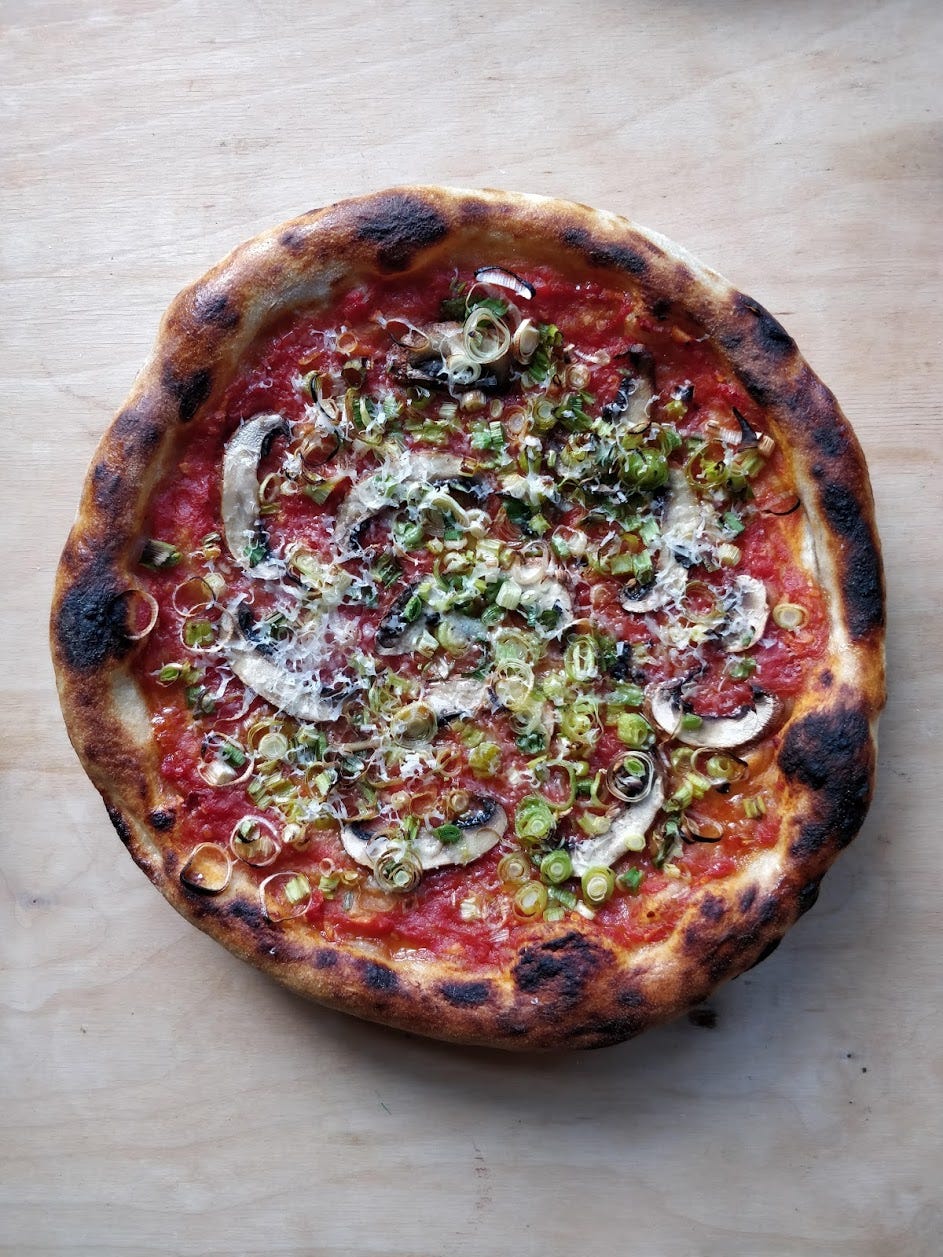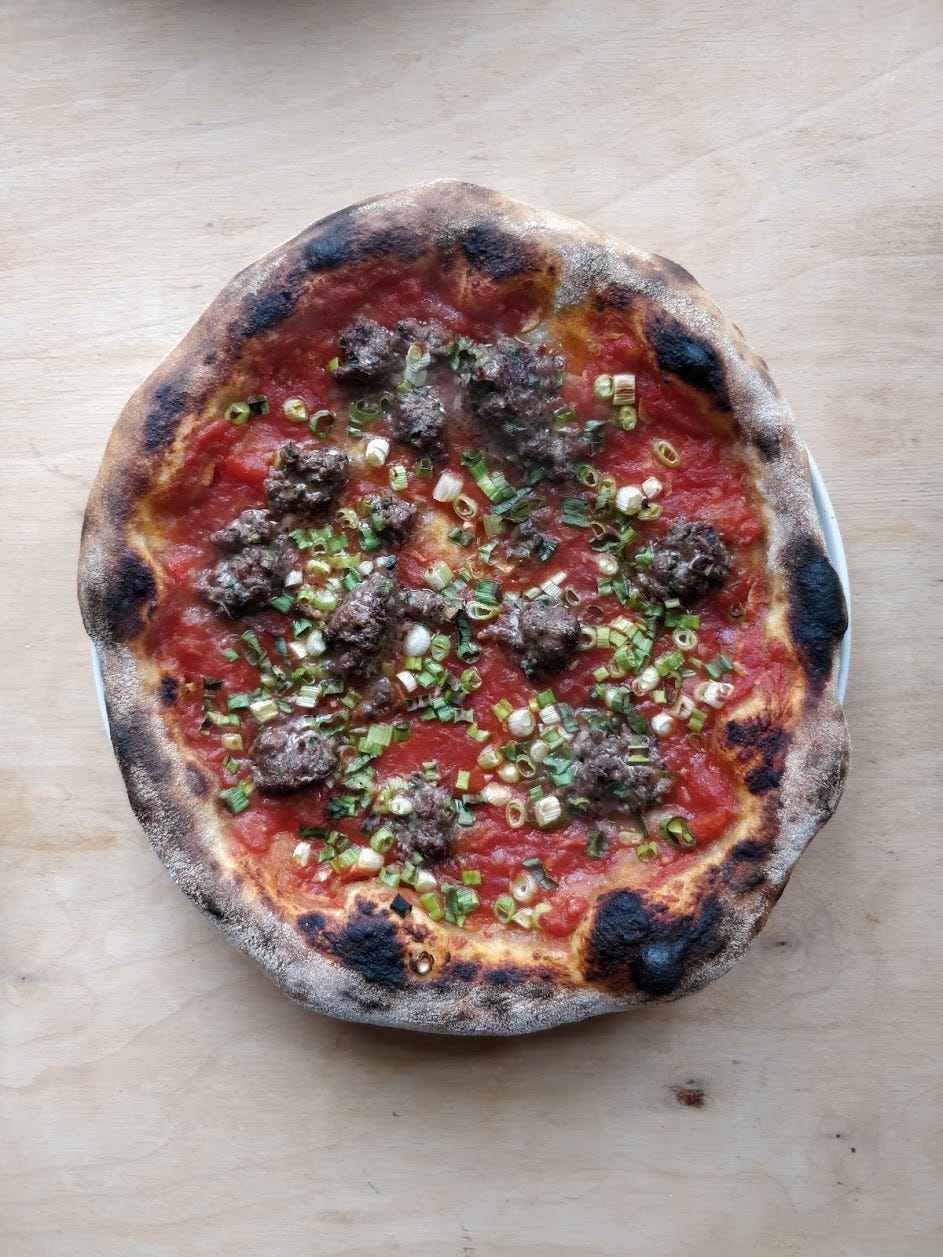#28: Ambient uncertainty, Part 2
How pizza dough can teach you to manage uncertainty.
I’m an author, organizational sociologist, strategy professor, unsuccessful furniture maker, and Xoogler—this is yet another of my attempts to make sense of the state of not-knowing. My first book, The Uncertainty Mindset: Innovation Insights from the Frontiers of Food, will be available in early June.
(It has already been mentioned to me that this issue’s subtitle is inherently absurd.)
Pizza has become my minor lockdown obsession. The most recent, which you see below, was wild garlic stems, leeks, scallions, chinese chives, mushrooms, and a spiced tomato sauce. This time, I tried brushing the rim with anchovy oil after baking, borrowing liberally from what I saw Hail Mary doing in LA.
(You can see some other recent pizzas here.)

For the home pizza eater, one approach is to buy and reheat a frozen pizza of the desired style and with the preferred toppings—there is almost no true uncertainty in doing this. If you’ve had that brand and flavor of pizza before, you know what you’re going to get each time you make one.
If, on the other hand, you decide to make your own pizza at home, you have choice beyond the options made available to you by the commercial-industrial prepacked food system. You can try and make any kind and size of pizza you want, topped with whatever you want, whenever you want—of course, within the limits of your equipment and ingredient sourcing ability.

The question is: Do you try to make the resulting pizza more predictable, or do you choose A Different Way? This is not about choosing pizza style or toppings, but about choosing an approach that either reduces or increases uncertainty.
Zooming in on just one decision—the flour you use for your pizza dough—illustrates this meta-choice.
Most pizza dough recipes specify 00 flour. This is a type of flour with small and uniform particles. It is milled on commercial roller-mills and blended to have more or less the same properties (type and amount of various starches, minerals, proteins) from batch to batch—every bag of 00 you get from the same mill will be more or less like the others.
Choosing to make the dough with a roller-milled 00 flour from a large commercial mill inherently limits the range of possible outcomes you will achieve in the dough. The texture as you mix and ferment the dough will be relatively predictable, which means the final pizza you make from the dough will also be predictable. Not necessarily a bad thing since that makes for a more predictable pizza dough.
But pizza dough doesn’t have to be predictable.
For an extreme example, instead of a commercial 00 flour you could choose to use a flour stoneground by a small mill from a harvest-specific population of diverse heritage wheats.
This introduces uncertainty in a few ways.
Compared to roller-milling, stonemilling creates a more unpredictably variable flour. The flour particles are more variable in size and shape, with a potentially dramatic effect on how the dough comes together when mixed and fermented. And small mills don’t have the capacity to do the kind of high-precision flour analysis and blending that large commercial mills do, so the flours they mill vary more from batch to batch.
Then there’s the question of the wheat from which the flour is made. Most 00 flour is milled from a small range of clonal varieties of modern wheat, each variety designed and grown to have predictable properties. In contrast, a heritage wheat population can consist of hundreds of different varieties of old wheats. The population’s composition—how much of each variety of wheat is in it—changes with every harvest because each wheat variety responds differently to prevailing growing conditions.
A heritage population wheat flour stoneground by a small mill will be different with every harvest and mill batch. Each bag of flour will make a dough with a different texture, and you won’t know how different until you actually use it to make the dough. You’ll have to use more or less water, probably ferment it differently, to get the texture you want. You may not be able to get the texture that you want anyway. (One batch of dough turned so soupy I ended up baking it in a skillet.)
Dough made from this kind of flour can be the Pizza Dough of Uncertainty.
Why choose this intentionally unpredictable route? Because this type of flour can actually taste like something. Wheat that has real flavor makes better-tasting pizza. When properly made—this is admittedly rare—normal pizzas made from industrial flour simply cannot compete. And the unpredictability of the outcome creates opportunity for true pizza innovation: Pizzas that are great in ways that could not have been anticipated.
Making pizza dough with unpredictable flour is, in its own small and absurd way, a form of cognitive and emotional training for uncertainty.
Pizza is trivial and insignificant in the greater scheme of things. It is a universal truth that few pizzas reach Greatness, but nearly all pizza is edible. Failing at pizza dough just means eating less delicious pizza. The stakes here really could not be lower. So pizza dough is an ideal tool for injecting low-level not-knowing into everyday life—a tool for creating ambient uncertainty.
Working in uncertainty is cognitively and emotionally difficult in ways that school, work, and society rarely teach us to deal with. To become good at working with and responding to uncertainty requires getting used to these challenges and learning how to overcome them.
One way to do this is to design uncertainty into daily life—to make it ambient and ubiquitous—but on your own terms: where the stakes are low and where there’s potential for a desirable reward.
Last week, in Part 1, I suggested that it helps to design personal routines around two principles:
Forcing continual low-level confrontation with uncertainty, and
Providing exposure to the serendipity of unexpected desirability.
Pizza at home could be one such routine: A way to force yourself to learn to work with a material that behaves slightly unpredictably, where your responses cannot be fully pre-programmed and decided in advance, and where the eventual outcome is not entirely certain—but can be unexpectedly delicious.

If you want to try this for yourself, I’ve developed a pizza dough recipe and approach that is fairly robust to different nonstandard flours. It is specifically designed to produce good results for underpowered, junky home ovens—and is what I use for all the pizzas I make at home. You can download the PDF here.
If you found this useful, it would make me very happy if you shared it with masses of people.
You can find previous issues of The Uncertainty Mindset here. I’m on the web at www.vaughntan.org, on Twitter @vaughn_tan, Instagram @vaughn.tan, or by email at <uncertaintymindset@vaughntan.org>.

